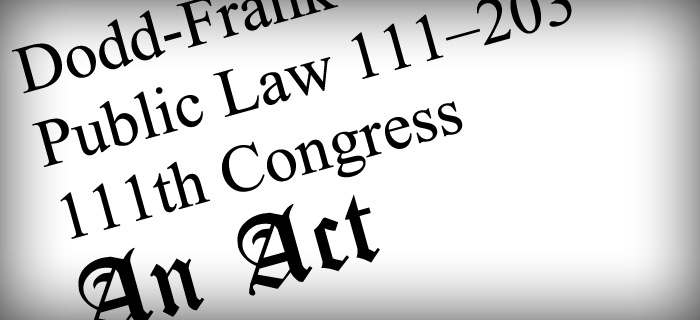Why Dodd-Frank is a Huge a Problem for Small Businesses
Believe it or not, a few years ago community banks flourished, serving the needs of their communities by providing small businesses credit in amounts frequently lower than $1,000,000. Now fast forward to today and a blizzard of regulations and compliance mandates forced onto the industry by Dodd-Frank has driven small banks onto the brink of extinction. As they disappear, small loan options dry up, making America’s businesses and entrepreneurs the real victims of an overzealous government.
The Number of Banks in the United States Is in Steep Decline
As recently as 1984, there were 14,400 banks in the United States. This figure remained relatively stable for several years, but by the end of the decade had begun a downward spiral. The number of banks continued to dwindle over the next three decades, and as of year-end 2016 there were only 5,083. That’s a 63.7% decline.
Yes, the savings & loan crisis drove over a thousand out of business and the “Great Recession” led to the closing of another 500, but the vast majority were simply swallowed up via mergers and acquisitions. The trend appears likely to continue unabated into the future.
Why Does It Matter?
Because of technological advances and the internet, individuals treat banking much differently from how they did back in the day. Online banking and automated lending platforms have made consumer loans – even mortgages – far easier to navigate. As a result, it can be argued that most consumers no longer need the one-on-one hand-holding and personal touches that community banks specialize in.
Business lending, on the other hand, is an entirely different matter. Although a certain amount of streamlining and semi-automation is possible, the fact remains that the relationship between a small business and its bank is just as critical today as it ever has been. Income streams for businesses are usually variable, subject to factors both within and outside their control. Opportunities to grow and expand sometimes can come suddenly and without warning. Debts may need refinancing or restructuring due to unforeseen economic changes.
In short, no matter what technological advances are made in the future, small business success and tailored, relationship-driven small business loans will always remain inexorably linked.
Dodd-Frank Is Drying Up Small Business Lending
The data speaks for itself.
In 2004, the percentage of small loans (under $1 million) by banks to businesses was 34.8 percent. By the third quarter of 2016, that percentage was in steep decline, having been cut down to just 19.7 percent. Why has it fallen so far in just the last 12 years? In addition to the loss of about 2,500 banks during the period, the primary culprit has been the Dodd-Frank bill.
On the heels of the financial crisis, Dodd-Frank was passed in 2010 as an attempt to rein in perceived excesses that helped lead to the financial crisis. Never mind the fact that sloppy governmental policies were at the root cause of the crisis: Dodd-Frank made banks pay a huge price by foisting so much regulation upon the industry as to literally choke out profitability. Lower profits, in turn, led to further mergers and consolidations, substantially reducing the number of choices available in the marketplace.
Although banking is generally profitable today, industry-wide profitability has decreased by nearly 30 percent since the years immediately preceding the financial crisis of 2008.
The Small Business Administration Has Tried to Help
Seeing evidence trending in the wrong direction, the U.S. Small Business Administration took steps to incentivize lenders into making more loans of $350,000 and under, offering fee waivers and reductions, simpler underwriting, and other value-added enhancements. And there have been some successes: SBA loans of $150,000 and under, for example, grew by 55.2 percent between 2013 and 2016.
But it’s a drop in the bucket compared to the overall trends within the economy. Dodd-Frank has made business lending so expensive that it’s now widely believed that the best way to make a fair profit is to concentrate on larger loans. That mentality might benefit much of corporate America, but it’s at the expense of the true engine of the economy: small businesses.
Regulatory Rollback
One of President Trump’s key platforms is to reduce the regulatory burden that has been hampering the growth of the economy. To that end, he has signed two executive orders in recent weeks, the first requiring the elimination of two regulations for every new one issued, and the second directing federal agencies to create task forces charged with evaluating rules and regulations. The goal of each executive order is to streamline and repeal regulations that simply do not make sense.
On balance, these are positive steps. However, they don’t go nearly far enough. The fact remains that it was the government that was the primary culprit of the economic meltdown of 2008, not Main Street banks. The only logical solution is the unwinding of Dodd-Frank.
Sensible regulation is fine and necessary; regulatory zealotry is another matter entirely.
Regulatory overreach is out of control and America’s small businesses are paying the price. It’s not simply about the macro-economy, however; the death of small loans is being felt sharply on Main Street. Fewer choices and a growing scarcity of small loans is cutting deeply into the heart of the American economic engine.
Thankfully, alternative financing options for small businesses helps fill in the gaps and help small businesses get off the ground and continue to grow. Our team at Rising 7 Capital are experts at getting small businesses the financing they need.


